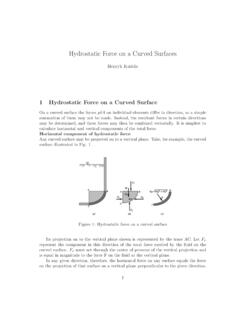Transcription of Lecture5 Hydrostatic Force on a Plane Surface
1 Hydrostatic Force on a Plane SurfaceHenryk KudelaWhen a Surface is submerged in a fluid, forces develop on the Surface due to thefluid. The determination of these forces is important in the design of storage tanks, ships,dams, and other hydraulic structures. For fluids at rest we know that the Force must beperpendicular to the Surface since there are no shearing stresses present. The pressurevaries linearly with depth if the fluid is incompressible. For a horizontal Surface , such asthe bottom of a liquid-filled tank , [2], the magnitude of the resultant Force is simplyFR=pAwherepis the uniform pressure on the bottom andAis the area of the 1: The Hydrostatic Force on a horizontal that if atmospheric pressure acts on both sides of the bottom the resultant forceon the bottom is simply due to the weight of liquid in the the pressure isconstant and uniformly distributed over the bottom, the resultant Force acts through thecentroid of the area.
2 For the more general case in which a submerged Plane Surface isinclined the determination of the resultant Force acting onthe Surface is more the general Surface shown in Fig. 2 The liquid acts on the Plane area shown asa section of the wall; a top view gives additional detail of the geometry. The Force on theplane Surface is due to the pressurep= gh= hacting over the area, ,F= ApdA= g AhdA= gsin AydA= gyAsin (1)whereyis the distance (mean value) to the centroid of the Plane area; the centroid isidentified as the point C. Equation (6) can also be expressed asF= gh(2)1 Figure 2: The Hydrostatic Force on an inclined Plane the vertical distance to the centroid. Since ghis the pressure at the centroid,we see that the magnitude of the Force is the area multiplied by the pressure that acts atthe centroid of the area. It does not depend on the angle a of inclination.
3 But, the forcedoes not, in general, act at the centroid (only in the case of some symmetry of the Plane ).Let us assume that the Force acts at some point called thecenter of pressure, locatedby the point (xp, yp). To determine where the Force acts, we must recognize that the sumof the moments of all the infinitesimal forces must equal the moment of the resultant Force , ,ypF= g AyhdA= gsin Ay2dA= gIxsin (3)whereIxis the second moment of the area about the x-axis. The parallel-axis transfertheorem states thatIx=Is+Ay2(4)whereIsis the moment of the area about its centroidal axis. So, substitution of Eq. (4)into Eq. (3) and using the expression for F from Eq. (6) results inyp=y+IsAy(5)Equation (5) permits us to calculate the location where the Force acts it is the center 1A 60-cm square gate (a= ) has its top edge 12 m below the water is on a45oangle and its bottom edge is hinged as shown in What Force P is neededto just open the gate?
4 Solution:The first step is to sketch a free-body diagram of theFigure 3: The Hydrostatic Force on a so the forces and distances are clearly identified. It isdone in (b). The Force Fis calculated to beF= hA= 1000 (12 + sin 45o) = 43130N(6)Now we find the distance d where the Force F acts from the hinge:y=hsin 45o=12 + sin 45osin 45o= +IsAy= + ( ) (yp y) = (7)The forcePcan be calculatedP=d F/a= 21040N.(8) The pressure PrismAnother approach to the problem of determining the resultant Force and line of actionof the Force on the a Plane Surface is given by the concept of the pressure prism. It is aprismatic volume with its base the given Surface area and with altitude at any point ofthe base given byp= gh,his the vertical distance to the free volume is called the pressure prism. The magnitude ofthe resultant Force actingon the Surface is equal to the volume of the pressure prism.
5 The fluid Force isF= volume =12( gh)bh= gh(h2)A(9)whereA=b hFigure 4: Pressure prism for vertical rectangular area. Thevolume of the pressure prismis equal to the fluid this lecture I used the following books:References[1] F. M. White, Mechanics, McGraw-Hill.[2] B. R. Munson, Young and T. H. Okiisshi, of Fluid Mechanics,John Wiley and Sons, Inc..4


